The world in which we live can be a scary place. Even now, before any potential collapse of society has happened it can still be scary.
Crimes happen every day – muggings, robbery, assault and many more that are worse. These crimes can happen at home, on the street, or in a place of business.
For this reason, many people feel the need to have a way to defend themselves from an attack of any nature. One way to defend yourself is to take self-defense classes or martial arts, which will teach you how to use your own body as a weapon against an attacker. I highly recommend this to anyone concerned about personal defense.
However, some people don’t have the time, finances, or desire to learn self-defense or martial arts, another effective way to protect yourself is to have a weapon in your EDC. There are a number of self-defense weapons on the market, and I want to give you a rundown of the best non-lethal self-defense weapons to have.
Table of Contents
Why a Non-Lethal Weapon?
The question comes up often enough in my dissertations on the subject. If you are in a self-defense situation, one truly worthy of the name, a person wonders why you wouldn’t immediately go to a lethal force option to save your own life or the lives of your loved ones.
This is a reasonable question, but one that is woefully shortsighted and completely lacking in the real-life context and constraints of self-defense in the 21st century.
There are many reasons why an individual would choose a non-lethal weapon, more properly called a less lethal weapon, for self-defense.
The first and most prominent is because lethal weapons might be proscribed or just heavily regulated in each state, or in a given jurisdiction within a state.
We all know places where it is effectively impossible to carry a firearm of any kind or even a knife substantial enough to protect yourself with. In such cases, a non-lethal weapon might be a more effective option than a “neutered” lethal weapon.
Yet another consideration is the joint tactical-subsequent legal problem that is inherent to any self-defense scenario while the rule of law is still in force. The bottom line is that not all self-defense situations call for lethal force, and many, many more than not require an intermediate level of force.
This leads us into the second half of the conundrum, the legal battle that will ensue in the aftermath of any use of force in self-defense. If a judge or jury decides that you acted unreasonably to include an inappropriate level of force, you can wave bye-bye to your freedom and the outside world. A non-lethal weapon always works in your favor in that regard.
Lastly, and it is one that should not be discounted, some people just have a serious ethical hang-up about using lethal force, and want a defensive option that is as effective as achievable while being the least likely to inflict lasting injuries or kill.
That’s not me, and it probably isn’t you, but it is a consideration for some, and we should all be grateful that effective options are available that fit the requirement.
Defense Sprays
There are a couple of defense sprays that you can use as non-lethal protection whether you are at home or out and about. These are Mace and pepper spray. When you spray the attacker in the face, their eyes and face will instantly be affected.
Self-defense sprays can be excellent options for self-defense because they are one of the few ranged, less lethal options that are highly effective in the right circumstances.
All are capable of causing searing pain, and in the case of certain formulations can cause inadvertent coughing, shortness of breath, tightening of the throat, copious mucus production and more.
When they work, they really work, and 9 out of 10 times a good application of self-defense spray will see an aggravated attacker lose the will to fight, and even if they don’t it is highly likely that they will be degraded enough where you will have an advantage in the fight or can even make good on your escape attempt.
However, contrary to what many people might think, pepper spray, tear gas, and mace are quite different, although the terms are often used interchangeably. Let’s take a look at each of these in detail:
Mace
Mace is essentially a type of tear gas. It does not have the inflammatory properties of pepper spray (see below).
Mace has been available for civilian use since the early 1960s, but law enforcement officials soon realized that Mace is not effective when it comes to incapacitating individuals who are under the influence of drugs or alcohol or who are particularly violent.
Mace is composed of white crystals that are suspended in chemical that is designed to be a medium for delivery. When the gas comes into contact with a person, the effects are immediate and painful.
The eyes will water and shut, and the nose, mouth, and throat will burn. The person will cough and choke as they try to breathe…
Mace may be thought of as an early entrant in the self-defense spray market, but it has long been surpassed in both police and civilian usage by proper tear gasses and especially OC spray.
You can use mace if for whatever reason it is the only formulation allowed in your country or other jurisdiction, but you have much better options that are far more effective these days. As a rule, choose pepper spray over all others.
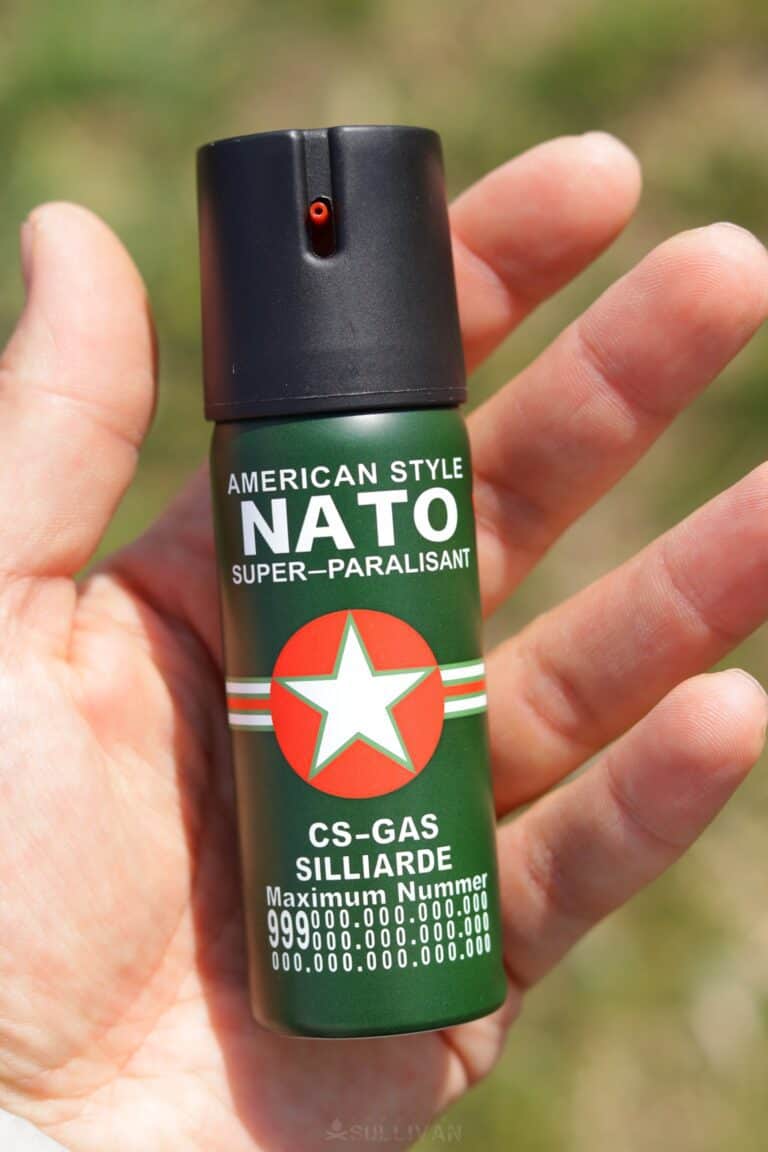
CN, CS and CN/CS
CN and CS gases, sometimes deployed in tandem as cn/cs, are proper tear gases. These lachrymatory agents cause furious stinging of the eyes and mucous membranes, difficulty breathing and can even deprive the lungs of oxygen
Long a staple in military and police usage, typically as a method of crowd dispersal and control it is sometimes used to soften up a target for an assault when the assaulters have the appropriate protective measures in place so they will not be affected by the gas.
Some people instinctively prefer tear gas sprays over pepper sprays because they are seen as military-grade gases or effective police tools, when in reality, as a less-lethal defense, pepper sprays are still far more effective for short, sharp engagements.
Again, if all you have available by law or supply is some variety of tear gas spray don’t think twice about employing it as they are generally effective in most conditions, but if pepper spray is available make sure you get that!
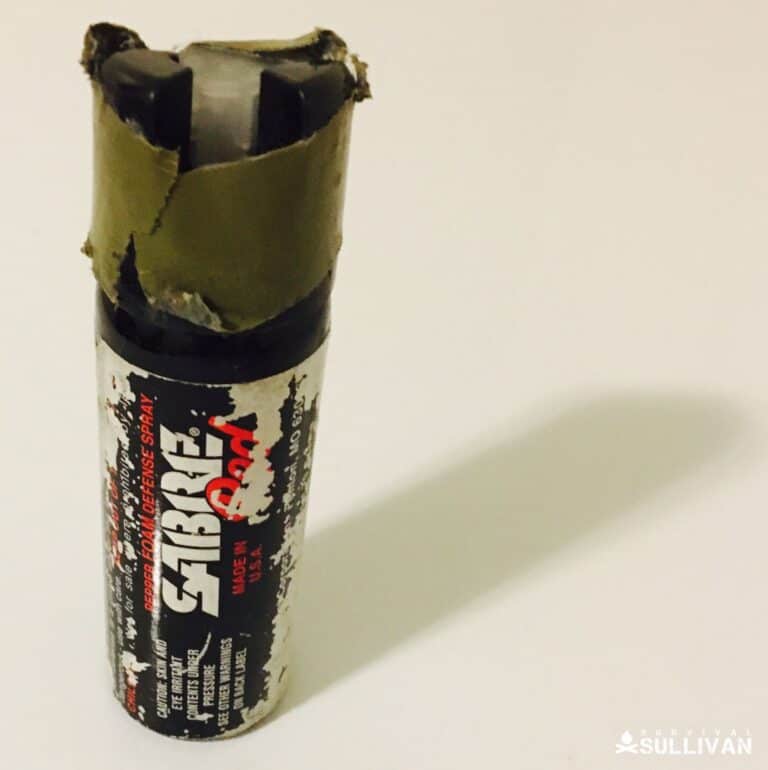
OC Spray
Pepper spray is in many ways the ideal less lethal self-defense weapon. It has the range (around a 10-foot / 3 meters range), potency and reliability to be a primary weapon capable of dealing with the vast majority of self-defense situations you are likely to encounter.
Keep in mind that most self-defense scenarios call for an intermediate level of force, not lethal force right out of the gate. It could be a mouthy drunk invading your personal space or a panhandler that is a bit too wild-eyed and insistent for comfort. Both call for a substantial dose with the hot stuff.
To use OC spray, aim the stream directly into the eyes, nose, or mouth of the attacker for maximum effect. If done correctly, they should begin to feel the effects after about 10-15 seconds.
Most of the time, the effects can last up to three or four hours (unless treated). This grants you plenty of time to further neutralize the threat, and escape.
Even better, pepper spray’s best attribute is how ubiquitous and socially acceptable it is. There is hardly any state or any venue in any state where pepper spray is expressly forbidden from being carried.
Yes, there will always be restrictions in some places of one kind or another, perhaps the formulation or the quantity you are allowed to have on hand, but even so this is a small price to pay for being armed with something that is almost universally useful.
When it comes to pepper spray, the brand (i.e. Sabre) really is everything because not all of these formulations are created equal. Like lots of other things, marketing mumbo jumbo muddies perception when it comes to what is and is not effective.
Generally, you want to look for a pepper spray with a formula containing the maximum allowed percentage of active capsaicinoids – for maximum strength. This natural ingredient, derived from peppers, is what gives pepper spray its heat or punch.
This type of spray consists of an active ingredient (oleoresin capsicum) that disrupts mucus membranes of the body after a few seconds upon impact.
For attackers that are under the influence of stimulants, they are more than likely too pumped up on adrenaline to associate the pain until later. For this reason you should never count on OC spray to immediately incapacitate the attacker.
Pepper Ball Guns
If the close range and wide area of effect that a typical canister of OC produces is a turnoff, or you just want that same spicy goodness available with greater precision, do I have good news for you! One of the newest and best self-defense tools available for those who can’t have or don’t want a firearm is the pepper ball gun.
A derivative of the rapid fire, “paintball-type” pepper munition launchers commonly employed by police against dangerous criminals and unruly crowds alike, the pepper ball gun fires a glorified paintball that is full of OC.
On impact, these pepper balls rupture into a hazy mist of hot stuff that is readily inhaled or quick to aggravate exposed mucous membranes.
Now, you might be thinking that a large, paintball style gun with an equally large hopper full of pepper balls on it is a great thing to have for fending off a mob surrounding your house, and it is, but it is not ideal for concealed care, which it isn’t.
Luckily, some companies have stepped up to the plate to produce small format pepper ball guns that are scarcely larger than a typical full-size pistol.
One such company, Byrna, makes a model that features detachable and replaceable magazines that function just like a typical pistol magazine, allowing you to top off your pepper ball launcher in the blink of an eye and keep deploying the hot stuff as needed.
Compared to many of the other non-lethal personal safety options on this list, the pepper ball gun has special viability for home defense as it is capable of engaging intruders at ranges well in excess of any other option on this list and doing so with accuracy.
It can also be used to preseason an area with a cloud of hateful OC in advance of the bad guys approach.
These are definitely a niche tool, not to mention an expensive one, but as discussed above OC is no joke and is truly one of the best non-lethal options around.
Palm-Held Weapons
Most preppers and survivalists are familiar with the tactical pen, the kubotan, and the self-defense keychain. The tactical pen can actually be used as a writing implement, but it is also solid enough to be used as a self-defense weapon if needed.
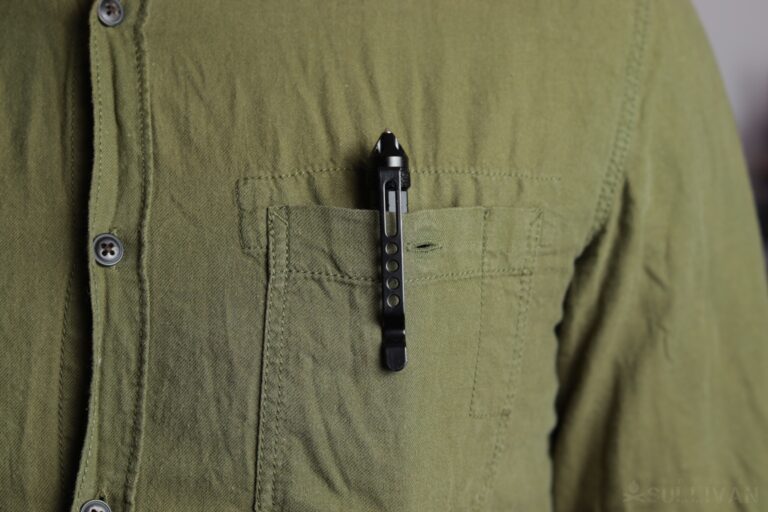
A kubotan is considered a pocket stick and is very similar to the tactical pen in shape, size, and weight.
The kubotan can be used as a keychain, or attached to one, but there are also keychains that come ready to be used as a self-defense weapon. These are highly inconspicuous objects, which adds to their effectiveness as a weapon.
You can easily hold the tactical pen, kubotan, or self-defense keychain in one hand. Because they are so small and inconspicuous they are often not recognized as a weapon and are great for use when in close quarters or a crowded area.
Another benefit to the tactical pen, kubotan is that because so many people are unfamiliar with these weapons and don’t know how to use them, they are less likely to be used against you if you lose control of them, unlike a more obvious weapon such as a folding knife or pepper spray.
However, when it comes to these small self-defense weapons, you need to know how to use them effectively.
There is absolutely no room for error when engaged with someone who is that close to you. A qualified instructor can show you the basics in a short period of time, depending on your learning ability.
Make sure you continue to practice the learned techniques in a safe environment, there’s no need to hurt anyone when you’re simply training. Practice makes permanent, not perfect, so make sure you’re practicing the right way.
These weapons are best used in combination with self-defense techniques and you need to practice regularly to hone your skills and stay sharp. The more time you put into developing skill with the tactical pen, kubotan, or self-defense keychain, the more effective you will be at using it in a self-defense situation.
Tactical Flashlight
Flashlights are another unassuming object that, if designed for the purpose, can be used as a non-lethal self-defense weapon.
First and foremost, the majority of assailants do not want attention drawn to them. If you have a flashlight and can shine it in their direction, they have less of a chance of surprising you and might very well run away.
A tactical flashlight is also effective when shone into the eyes of an attacker. A bright light right in the eyes is very effective in self-defense because it can temporarily blind an assailant, giving you a chance to get away.
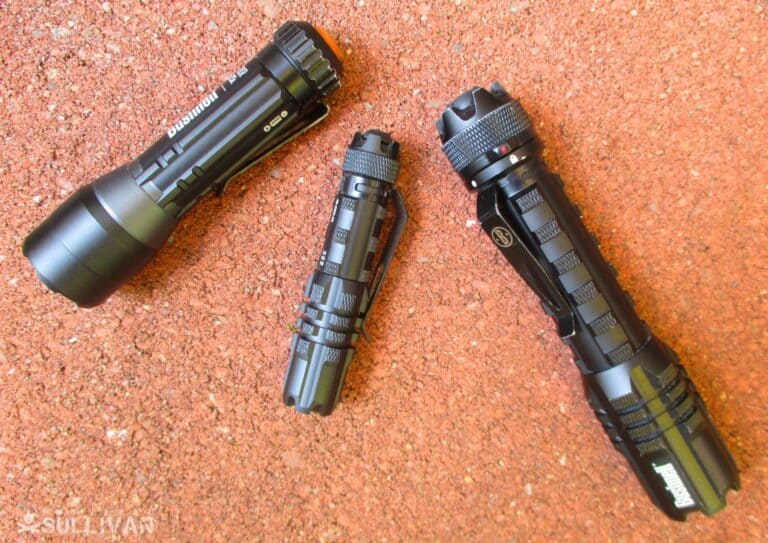
A tactical flashlight with sharp edges can also be used as a striking weapon if the assailant is still attacking. It can be used much like the tactical pen, kubotan, or self-defense keychain to disable an attacker enough to get away.
Aside from this, there are many other benefits to carrying a tactical flashlight. They are very discreet and unassuming. No one would think twice if they saw you with a flashlight.
Even when getting on a plane or going to school your tactical flashlight can go with you when other weapons are banned. Plus, it’s handy when you get into other types of situations, such as when your car breaks down at night or you need light to escape a dangerous situation.
No matter what other non-lethal self-defense weapons you might carry, you should always carry a tactical flashlight. Just make sure it is a flashlight that has been designed for tactical purposes, not just something from the dollar store.
Kitty Spikes
Chances are you are familiar with brass knuckles, those devastating and infamous fist load weapons capable of staving in a human skull with a good, stiff shot.
Compact and undeniably effective, brass knuckles have much to commend them when it comes to the application of lethal force but we are trying to avoid that within the confines of this article, after all.
Enter the kitty spikes. These half-decorative, half-serious business defensive weapon is generally classified as a non-lethal or less lethal tool depending on the styling.
Speaking of styling, this fist load weapon appears to be a cartoonish looking cat head complete with oversized eyes forming the finger holes with the mouth of the cat being held in the hand, just like brass knuckles.
Protruding in front of the fingers are the cat’s ears, usually blunted prongs but sometimes sharpened spikes. It is the former variation that we are concerned with because it will not pierce or mutilate an attacker.
But what it will do, however, is amplify the force of a punch to an excruciating degree, causing terrible pain on impact and targeting muscle bundles and nerve clusters.
This will definitely give someone incentive to “GTFO” and leave you alone. This is a defensive tool that relies on strength and some skill and striking, but this is an ideal one for people who already have some seasoning or serious experience when it comes to hand-to-hand combat.
Note that these are generally legal throughout the United States, but some states and jurisdictions do classify them like any other brass knuckles or fist load weapon, and they might be restricted in kind so take care.
Stun Devices
Stun devices come in many shapes and sizes. They essentially work on the same premise as static electricity, in which a body with a negative charge comes into contact with a body that has a positive charge.
Typical stun devices boast a voltage of 150,000 volts or higher. This might seem high but consider that a typical shock from built-up static electricity, say from rubbing your feet on the carpet and touching a doorknob, can release 25,000 or more volts of electricity.
Stun devices are generally non-lethal because the high electrical charge is released in a small area of the body.
Ideally, you want a stun device that has a rechargeable battery so that you aren’t constantly buying new devices and/or batteries.
- Stun Gun: A small hand-held device that releases between large amounts of voltages of electricity from two electrodes. About the size of a flashlight, this device can fit in a purse or pocket.
- Stun Baton: This is a stick that is up to 18 inches long and can deliver 800,000 volts of power. The end of the baton can be electrified, but some can also carry current along their sides, which will stun anyone who tries to grab the weapon. This can often be carried on your belt, but it is more difficult to conceal.
- Cell Phone Stunner: A stun gun disguised as a cell phone. This device can’t make or receive calls, but it can take out an assailant with as much as 4.5 million volts of power. It is also rechargeable and can fit in a pocket, in a purse, or on a belt.
- Flashlight & Lipstick Stunners: Small and easily concealed, these stun devices can pack a punch, but can be kept hidden in a purse or coat pocket. They come with a safety switch and are rechargeable.
It is important to remember that if your assailant has thick clothing, such as the clothing worn during the winter season, the stun device may not be effective, unless you strike bare skin (like the neck).
For this reason, it might not be the best self-defense weapon to use if you live in a colder climate, at least not for the cold season. This is because most people are bundled up to negate the colder weather.
It is also important to note that you need to train and practice the use of a stun device. The more time you put into learning how to effectively use it, the more likely you are to defend yourself against an attacker.
Make sure you practice safely, as these weapons can cause serious injury and burn scars if used carelessly. Always practice in a controlled environment.
Self-defense Whip
A self-defense whip, colloquially called a stinger whip after one of the most prominent and successful manufacturers of such tools, is a little more than a thick braid of metal wire that is sheath in a slick, mylar coating. This wire is attached to an aggressive, deeply grooved handle that provides a sure grip for the user.
Operation is the picture of simplicity itself: Swing for the fences and hit them with the end of the wire. The coating will generally prevent the wire from lacerating skin but it builds up tremendous velocity at the tip and the impact, particularly on sensitive parts of the body, is extraordinarily painful.
Combined with how quickly the whip can be swung it makes for a great deterrent against attackers who are not extremely motivated or truly out for your blood.
Also, the very nature of the whip allows a certain amount of flexibility in application of force, if you will pardon that awful pun. Strikes to the limbs, while highly painful, are extraordinarily unlikely to inflict any truly lasting injury while giving someone a, ah, vivid incentive to desist with their behavior.
If greater force is called for, strikes can be directed at the face, head and neck.
Strikes to the neck could well incapacitate whereas a strike to the face could damage or destroy the eye or knock out teeth. Not for nothing, this is one of the few non-lethal weapons that affords the wielder great reach.
This is another great option for self-defense in places where other weapons are tightly regulated or just not an option, because most jurisdictions don’t even have laws on the books about these whips.
It is worth mentioning, however, that some states might classify it as a flail or similar martial arts weapon and that means it’ll be regulated accordingly. Highly unlikely based on my assessment, but I have noted it here for completeness so that you may do your own due diligence.
Taser
A Taser is quite different from a stun device. Where a stun device just zaps a person with a focused electrical current in one small area of the body, a Taser is computer controlled and is designed to release a current that will actually disrupt the signals going from the brain to the muscles of the entire body.
To use a Taser, you must fire the electrodes from the device, much like firing a gun. There are two electrodes, each of which is attached to a long wire.
The electrodes must hit the target and penetrate the skin (they are barbed), which means if the attacker is wearing thick clothing, the Taser will be ineffective.
The current released by a Taser flows through the electrodes into the body, so the electrodes have to hit their target in order to work.
The farther the electrodes are away from each other upon impact, the more effective the taser will be. This is because it generates more of a current between the prongs.
Most tasers have a “dry stun” option, so if you miss your shot with the electrodes, you can use the taser like a stun gun. The most effective area to use the dry stun is the neck.
This area of the body has the softest tissue with nerve clusters, making it ideal for maximum effectiveness. Never buy a taser that doesn’t have a dry stun capability, otherwise you’re limiting yourself to a one-shot capability.
Projectile Weapons
There are a number of non-lethal projectile weapons that can be used for self-defense. These are weapons that can pack a punch, but are small enough to be concealed in a purse or in a pocket. Care must be taken with these weapons, as they can be lethal if not properly used. These include the following:
- Rubber bullets: These can be shot out of a standard firearm, but they will not kill (although they hurt – A LOT!) unless you are firing at close range. In order to use rubber bullets, you need a firearm and that means you have to go through the process of getting your firearms license/permit and purchasing a firearm.
- High-velocity slingshot: A slingshot that is generally made out of lightweight aluminum and has a leather pouch. Its range can be as high as 120 yards.
Keychain Options
Alarms
Personal alarms are great because you’re not making contact; you’re making noise. The last thing anyone wants in a self-defense situation, or potential self-defense situation, is to have to fight off a larger, stronger opponent. That’s where these little guys come in handy.
They’re small and easy to carry, in your purse or on a key ring. Despite their small size, however, they’re ridiculously loud.
A single button press sets off a loud horn, and suddenly you’ve got dozens of eyes on you – it’s kind of like screaming ‘fire’ instead of ‘help’ – it’ll get attention faster.
Bad guys are less likely to do anything if they’re being watched by scores of other people.
Another good alarm you can use is a whistle. Signal whistles are used in water sports and on hiking trails to signal for help, it stands to reason they’d do just as well in an urban setting.
Expandable Batons
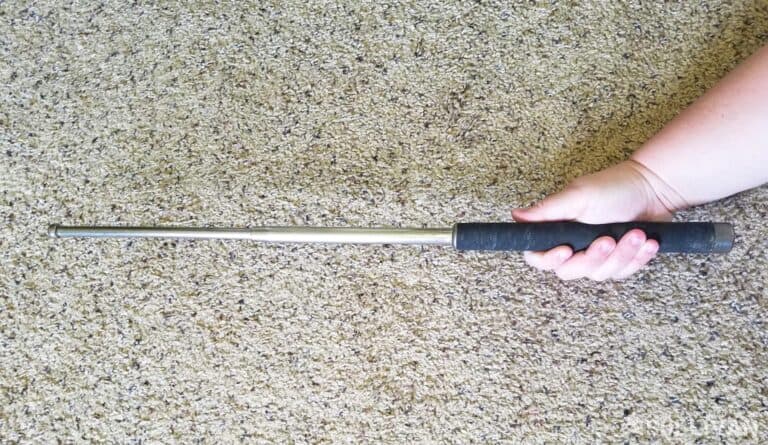
Expandable batons are typically lightweight and easily concealed in a compact package that you can attach to your key chain for rapid deployment. They’re relatively cheap and easy enough to use – a couple of good whacks with this and I doubt anyone’s going to hang around. As an impact weapon it’s not likely to do extreme damage unless you put an awful lot of energy into a swing.
Cautions
Now that you know the best non-lethal self-defense weapons for your EDC, it is important that you are also aware of the following cautions when it comes to using these weapons:
Legality
Not all of these weapons are legal to carry in all states. Before you choose and purchase any of these weapons, you need to check the laws in your state. For example, all states permit the use of pepper spray as a self-defense weapon, but some states have certain restrictions on its use.
While most states allow the possession of personal nunchucks, a few, including California, New York, Arizona, and Massachusetts, do not. In addition, even if state laws allow the use of any of these weapons, they might not be allowed at the county or city level.
Whenever you have any self-defense weapon, even a non-lethal weapon, it is still viewed as a weapon in the eyes of the law.
When you get into a situation in which your safety is compromised, and you pull out any one of the weapons listed above, you have pulled a weapon on another person and it will be viewed as such in a court of law.
You will need to be able to prove that it was necessary to introduce the weapon to the situation in order to ensure your safety, which means you will need a very persuasive argument for the use of the weapon.
Safety
First, when it comes to the use of the sprays, any pepper spray or mace will only be effective if you are upwind of the target. If you are downwind, you risk spraying yourself, rather than your attacker.
Also, if you are too close to the attacker, you will not be able to use the spray without it affecting you as well. The attacker must be within a few feet of you, which is relatively close. Even if you successfully use your spray, the attacker might still get close enough to cause you harm.
Second, most of these weapons require some level of training and regular practice to use. Whether you have a stun baton or rubber bullets, you need to have skill when using them, otherwise your attempts will be ineffective and you are at risk of getting badly hurt by your attacker.
Finally, all weapons can be used against you. If you are going to carry a non-lethal self-defense weapon, then be sure you know how to use it. If you can’t effectively defend yourself with it and there is a chance your attacker can get a hold of it, then you might just be putting yourself into a worse situation.
In addition, many of these weapons have the ability to cause death to the assailant, particularly if the user is unskilled. You need to use caution and good judgement when using any of the above weapons.
Be Prepared
In this world we sometimes have to take our safety into our own hands if we want to have peace of mind, but we have to do so within the extent of the law and with extreme caution.
Having a way to protect yourself when someone threatens your safety or your life is important. Plus, these non-lethal self-defense weapons will be useful in the event of a societal collapse, when the safety of you and your family is definitely compromised.
Also keep in mind that these non-lethal self-defense weapons are not just for your everyday carry kit (EDC), they can be a part of your home security plans, regardless of whether you have or are allowed to have firearms.
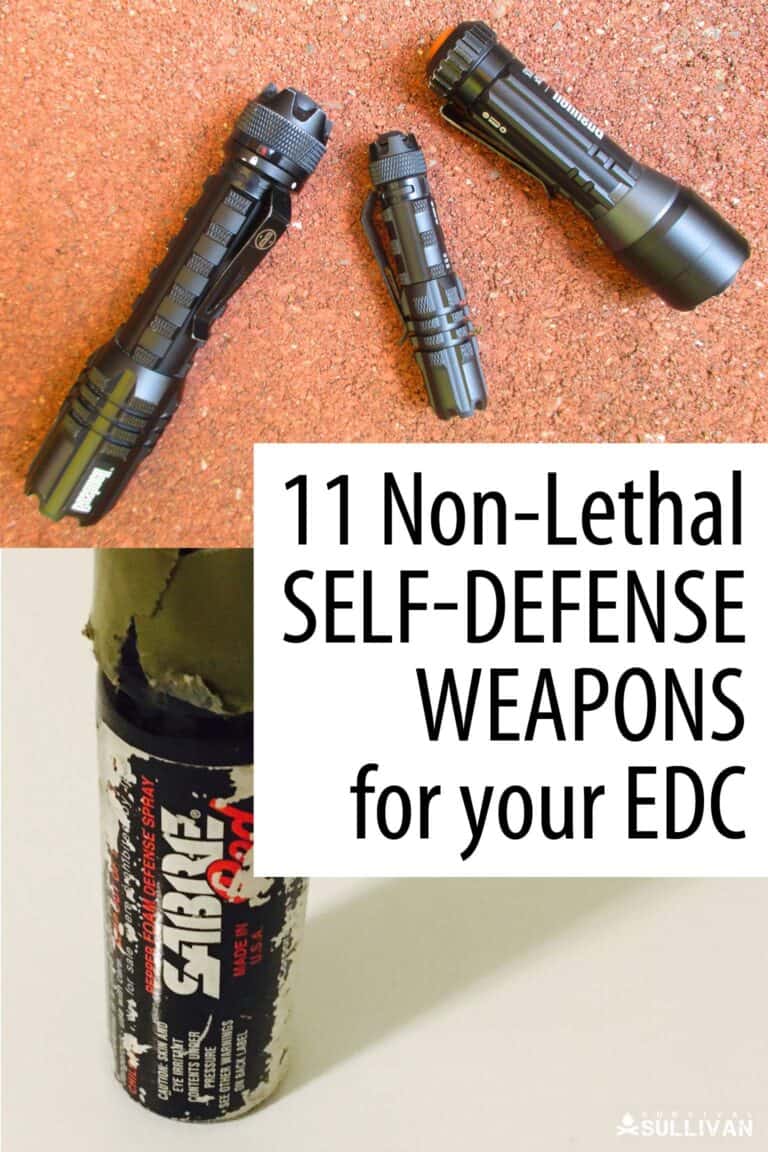

An urban prepper and rural wannabe, Karen has been working as a freelance writer for a decade and prepping for about half that time. She has gathered a wealth of knowledge on preparing for SHTF, but there is always more to learn and she has a passion for gathering and sharing that knowledge with other like-minded folk. Karen lives in London, Canada with her two children and plethora of cats.

I am disabled and in a wheelchair. I carry a collapsible baton, similar to what cops carry, with me everywhere I go, and keep it within reach even at home in the event there is a break-in. It is considered a non-lethal weapon and is legal to carry. Before I ended up in the chair, I was trained in sword fighting and staff fighting (via the SCA), non-military, and know how to use the baton well. Although this might not be the choice of some, it is a dandy self-defense weapon and easily carried and used.
I know that wasp spray and bear spray were not intended to be used on humans making pests of themselves. But I pointed out to my elderly folks that the wasp spray they have might come in handy in this manner. Both also shoot 10-30 feet according to their labels, and in the absence of wind may be a good substitute for pepper spray. Was wondering what the authors opinion is on their use as a last resort self-defense tool in the home. (I think my mom keeps hers tucked away by the front door). Thanks for the helpful article.